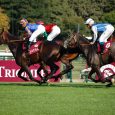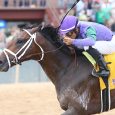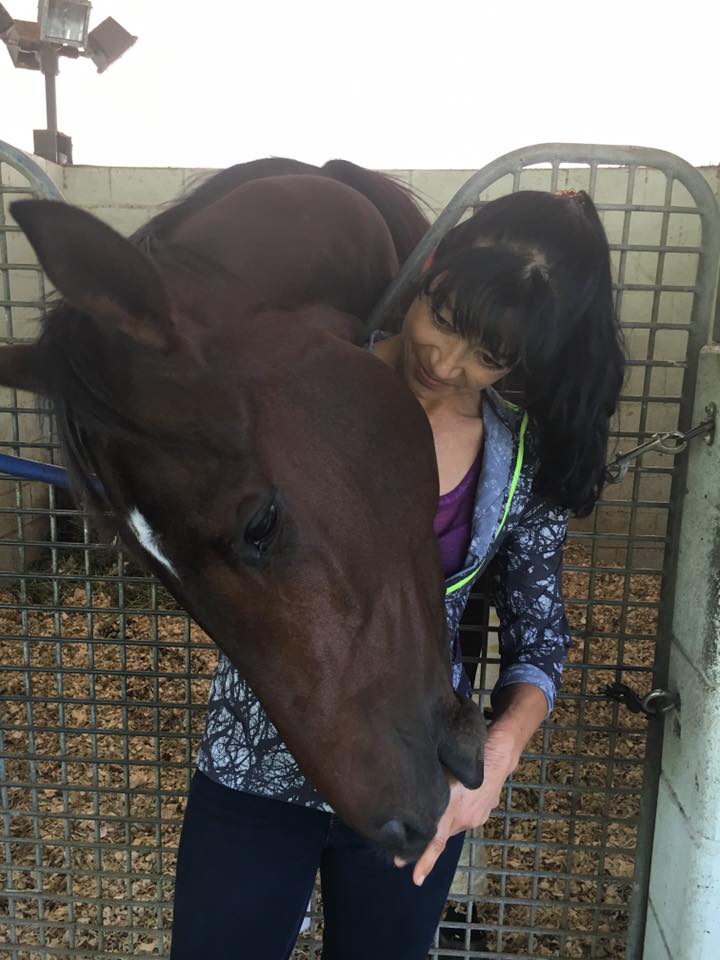
Michelle Nihei at Palm Meadows (photo courtesy of Michelle Nihei).
A western Canadian sunset, with the silhouette of a young girl on a horse, riding until the sun could no longer be seen and her parents beckoned her to come inside, perfectly captures what was a routine day in the life of a young Michelle Nihei.
Passion, confidence and knowing who you are and what you’re meant to do can be the difference between living and merely existing. And Michelle Nihei has always lived life to the fullest.
It was apparent from when she began riding them at the age of two that horses were going to play a major role in Nihei’s life.
“I wouldn’t let [my parents] peel me off until I was probably starving to death or it got dark, or something like that,” said Nihei of her early riding endeavors. “It kind of progressed from there in a rapid motion. I continued to ride whenever I could, or whenever my parents would let me.”
Opening new doors
The daughter of a biochemist and an attorney, the Calgary, Alberta, Canada-born Nihei relocated to the Golden State with her family because her father took a sabbatical at the University of California — and it was there she began riding show horses.
However, it wasn’t until Nihei returned to western Canada that her development as a horseperson began to expand, as she explored new horizons and became involved with different disciplines.
“I got a little bit more involved with the rodeo people, with barrel racing and riding,” said Nihei. “So, I was taking trail rides out as an outrider at a pretty young age, when I was 11 to 14. I broke Quarter Horse babies and I rode in a few Quarter Horse races out in the bushes, bush leagues. It was kind of a rough and rocky cowboy style. I was involved with just about anything I could get involved in, if it had anything to do with a horse.
“I was showing halter horses, riding cutting horses, reining horses and western pleasure. When I got on another show horse and had the opportunity to jump around fences, I kind of carried that through my university years [at the University of Saskatchewan]. I eventually ended up in the United States,” Nihei said.
Athletics and Academics
Those early lessons, combined with Nihei’s fiercely competitive nature, allowed her to excel not only in equestrian sport, but also in athletics and academically.
A dynamic force, with boundless energy, Nihei found a series of outlets through sport to harness that vitality on a consistent basis. She played volleyball and basketball and was also a middle-distance track runner, but equestrian sport and horses provided her with a deep fundamental core — one that would help her stay focused on defined objectives and reach her goals.
“It gave me a huge foundation not only to be involved in athletics for the rest of my life, but also to relate to other athletes, whether they’re human or equine,” said Nihei. “It has to do with conditioning, nutrition, mindset — all of the aspects of competition. Things that you would want someone to understand if they were coaching your kid or your horse.”
Goal-Oriented and Achievement-Minded
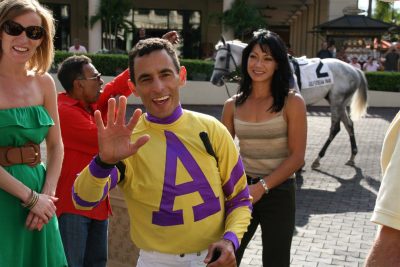
Jockey John Velazquez and Michelle Nihei (photo courtesy of Michelle Nihei).
It was the ability to maintain her focus with a series of defined objectives that allowed Nihei to achieve and attain goals in extremely competitive fields.
It was clear even from a distance that, no matter what she did, Nihei was passionate about it. She loves sports, academics, neuroscience and spending huge amounts of energy, time and life on research projects and clinical studies. However, what she found was the real underlying passion in her life was being involved with horses. And it was that compelling variable that served as the impetus to shape the direction of her future.
“I think early on in my other careers, I felt I needed to follow a course of action, a path that seemed to be destined by my innocence, my so-called heritage,” said Nihei.
It was attaining those goals, achieving academic excellence, being a member of the faculty at Johns Hopkins, and being involved with important research projects and clinical studies that made Nihei take a closer look at her life. She obtained her doctorate at the University of Kentucky and did her postdoctoral work at Johns Hopkins.
Once Nihei had attained her goals academically — goals that were important to herself and her parents — she began looking back at other things that she wanted to accomplish in her life.
A Vocational Transition
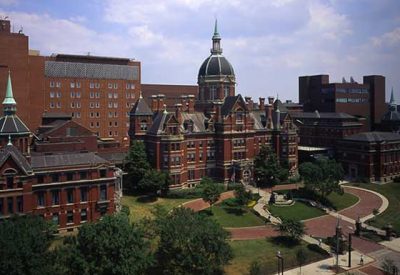
John Hopkins (photo via www.hopkinsmedicine.org).
However, as with anything in life, there are those variables that are beyond our control, ones that, for whatever reason, create challenges.
“There are always internal politics,” explained Nihei. “Whether or not you’re in love with what you do, or if you don’t love what you do, the politics is the hardest thing.”
The horses provided Nihei with a means of escape, giving her some succor from her sometimes stressful career.
“I realized that if I was going to endure something … I’d rather be doing exactly what I wanted to do or mostly what I wanted to do,” she said.
The transition from one life’s work to another began to take place when Nihei made the decision to leave Johns Hopkins and relocate to Lexington, Kentucky, where she accepted a position at Gluck Institute, allowing her to pursue two of her passions simultaneously.
“I was trying to find middle ground with what was expected of me and what I wanted to do,” said Nihei, adding that she realized working with horses “meant more, in a greater way, than neuroscience did.”
“I just sort of folded up shop and decided I was going to be at the racetrack,” she said.
Turning a Dream In to Reality
A virtual unknown to those in the thoroughbred industry, Nihei would make her initial foray by galloping racehorses at Keeneland.
“It was back in the day when the Rice Road barns were called the ghetto and, since then, they’ve become Park Place,” said Nihei, laughing. “Back then, you drove back there and it was all the little trainers, who would stay around for the summer and probably wouldn’t have a chance to have a stall on the main side, because they clear out for the sales. It was trainers who only had a few horses here and there. Most of them didn’t have a full barn.”
The environment proved to be conducive for Nihei to find freelance work, with the preponderance of the outfits not having a salaried rider. However, even with that being the case, a trainer with salaried riders decided to give Nihei a chance — Mary Jo Lohmeier.
“She would use a new good freelance rider, here and there,” said Nihei, noting that Alice Cohn and George Arnold Sr. also provided her with opportunities during that time.
“So, I was really fortunate. These trainers, particularly the women, took me under their wing a little bit. They said, ‘All right, these are the rules of the road and then you’re on your own.’”
The reception initially was mixed. With Nihei being an unknown, trainers on the backside, though not unkind, were apprehensive — not knowing what she could do with a horse and not having seen her ride. She understood the way they felt, even more so now that she has her own stable and responsibilities to owners with horses in her barn.
Living the Life She Wanted
In no way was the change in career an easy decision for Nihei to make. It was solely driven by a question of great gravity, one that she would often pose to herself: What will it take for me to be happy?
“That’s very difficult [question] to ask, but it’s even more difficult to answer,” said Nihei. “The comments that I had initially were from my colleagues and friends, who all tried so hard to dissuade me. There were very few voices around me who were supportive and encouraging. I really had to block out whatever everybody else had said to me. I had to identify whether or not I was making the right move.”
But when Nihei began spending more and more time around the racetrack, she knew she had made the correct decision. Still, the neuroscientist was faced with a series of challenges few encounter when changing vocations and without belief and confidence in her own abilities, it may have turned out far differently.
“There are very few transitions that are this hard,” said Nihei, “… from one area of life that requires so much time and effort to be able to get into — and I’m speaking about neuroscience — to move into a completely separate, different industry altogether, in every possible way.”
Nihei’s courage, along with her incredible discipline and confidence and a deep passion for what she wanted to do helped allay the fears of many of those closest to her.
“It was perhaps, justifiably worrisome for my friends who didn’t understand the leap, but I think as time went on they recognized that I truly and honestly was making it a life commitment for something that I loved to do,” said Nihei. “They sort of threw up their hands in terms of understanding why, but those who understood me as a human being, said, ‘I get it.’”
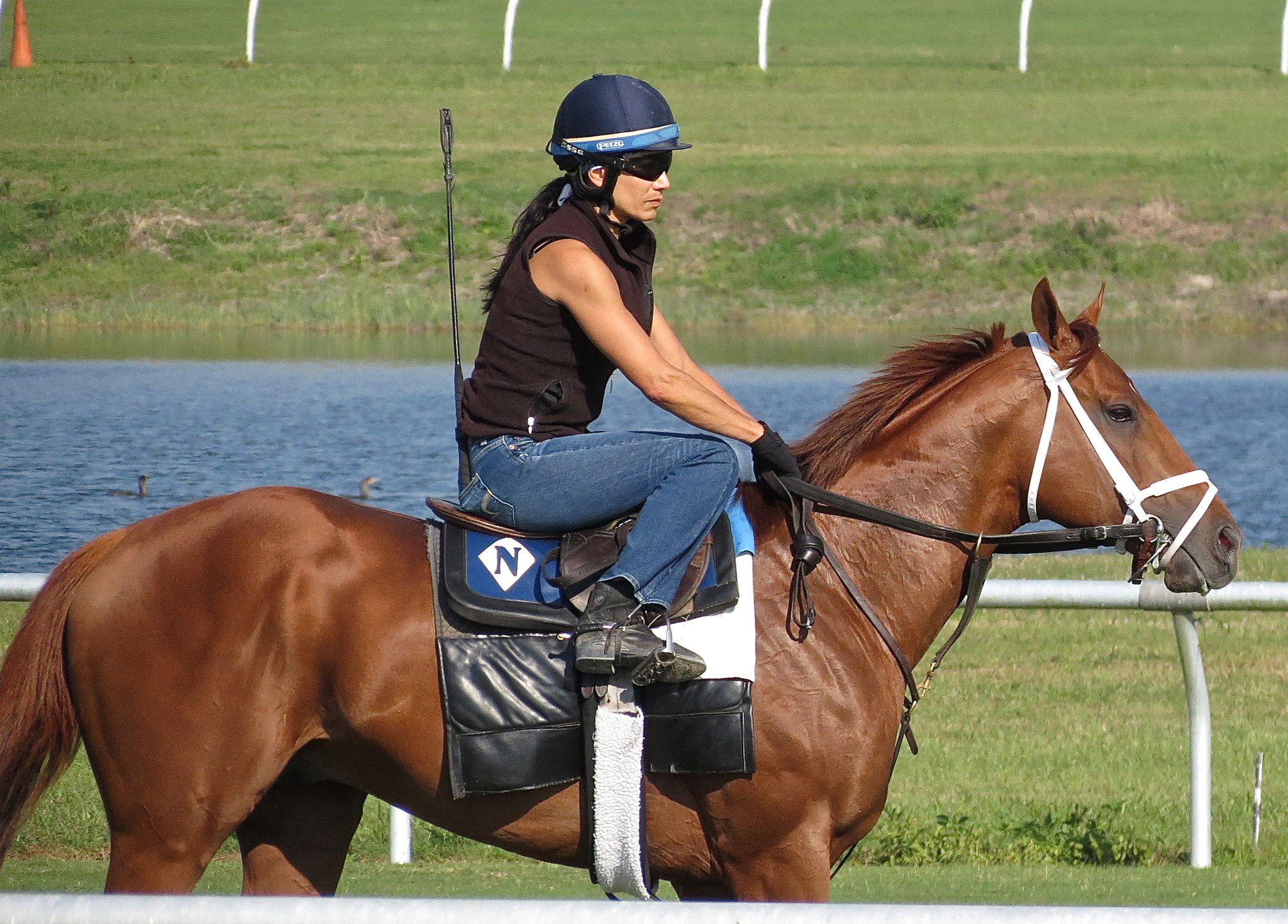
Michelle Nihei (photo courtesy of Michelle Nihei).
Patience and Persistence
The horsewoman would spend time working for a number of trainers, including Dallas Stewart, Rebecca Maker, Andrew McKeever and Christopher Speckert, who would all play a role in Nihei’s decision to achieve her objective of becoming a thoroughbred trainer.
“They certainly played a role in helping me to stay — a reason to begin that one step at a time,” said Nihei. “I don’t know if any one of them saw anything in particular. I think they recognized the sincerity and the genuine desire to be there, to show up every day. And, really, in this business, what you have to do is show up every day.”
Letting Her Actions Speak for Themselves
The depth of Nihei’s education was never an issue. She didn’t tell anyone about her academic background and she was an unknown quantity. There were far more pressing character traits that would resonate with trainers.
“What they want to know first is whether or not you’re going to show up in the morning and if you can ride,” said Nihei. “I could ride and showed up every day. And that’s all that matters, initially. I think that I established that I was a respectable, credible and trustworthy individual to begin with. I never tried to rest on my laurels or not do something because I had a few more years of education than somebody else. I hot-walked horses, I helped clean stalls. I trucked the muck as much as I could. So, I never said ‘no’ to a job, no matter how dirty or how tough it was.”
When people did find out about her extensive academic background and previous career, they were astonished by it, but Nihei’s character, work ethic and horsemanship had already solidified her place within the industry.
“I think the surprise was more about why are you doing this? It was because I proved that I could do it, and that was more important. I didn’t want them to think that when they found out who I was, there was a chance that I would turn up my nose,” said Nihei.
More Responsibility
Nihei’s ability to adjust to any situation, disciplined approach and mindset has allowed her to face challenges and succeed in a competitive sport and industry. The learning curve for the horsewoman was meteoric, as unexpected circumstances called for her to obtain her assistant trainer’s license in 2002.
“When I first started working for Chris Speckert, he became ill with diverticulitis and had to go into the hospital,” said Nihei. “Kentucky made me take the written and the oral [exams], which rarely seems to happen anymore. It was within my first year of starting on the backside. I hadn’t been on the racetrack for a year.”
An Opportunity for Growth and Changing Locations
A shift in location from Lexington to New Orleans and a change in the number of horses in Speckert’s barn, provided Nihei with the opportunity to move to Rebecca Maker’s barn, where she worked as an assistant trainer and exercise rider. A short time later, a series of propitious events would allow Nihei to move to what was becoming thoroughbred racing’s most successful operation.
“When I was at Keeneland, she [Maker] was thinking about staying in Kentucky, which would’ve worked well for me,” said Nihei. “She ended up deciding that she was going to go to Arlington and I wanted to be closer to my grandparents, who lived in New Hampshire”
Word of mouth on the backside of a racetrack is mercurial and Maker indicated to her that one of Todd Pletcher’s assistants said if Nihei was ever looking to make a change and needed a job in New York, she would be welcome in the barn. Nihei began working for Pletcher in May of 2003.
“Because I started with his slope of acceleration, it was a much bigger barn, but it wasn’t the behemoth until later in the year,” said Nihei. “He had just started to really grow. We went from 20, to 40, to 80, to 200 — that sort of exponential spurt. I just arrived right during the growth of all that. [Pletcher] had a string at Belmont and Monmouth, and the Saratoga string maybe the year before really got big and then, that year, exploded. That’s why they knew they needed a lot more riders, people who could do a little extra here and there.”
The transition was a period of fecundity for Nihei, as the environment was conducive to learning and provided opportunity with the expanded workload.
“I really didn’t get to spend a lot of time around Todd initially, not until a little bit later,” said Nihei. “There was a lot to do there. It was the perfect environment for me, because there were plenty of horses, plenty of jobs within our barn. We didn’t need just riders. We needed people who helped check temperatures. We needed people who checked feed and people to hold for the vet and the blacksmith. So, at many levels, there were so many things to do. It gave me a platform, not just to be helpful, but to be helped.”
A Lesson in Adversity and Triumph
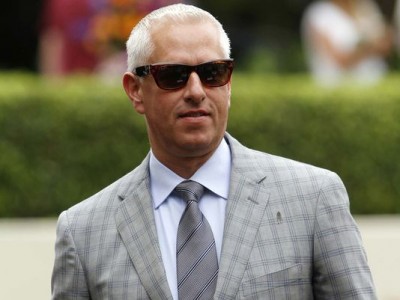
Michelle Nihei credits her time with Todd Pletcher and other top trainers with helping her fulfill her dreams (photo courtesy of Michelle Nihei).
However, Nihei’s world changed in 2007, when a riding accident at Palm Beach Downs while working for Pletcher literally altered her career path. She was facing life-changing decisions because of the severity of the injury.
It was her right knee.
The position of the tendons were so compromised that there was no circulation to the lower limb. Amputation seemed more than a strong possibility, but a friend, Kim Valerio, thought she should seek a second opinion. A fixator held the knee cap in place and Nihei didn’t feel amputation would be the correct decision.
“I knew through the fog of all of the rest of it, I remember him saying that he wasn’t willing to even consider attempting anything close to trying to put that knee back together again. I remember him saying ‘Good luck finding somebody.’ I said, ‘Oh this is great.’”
However, Nihei’s character and mindset played critical roles in her recovery from what was a devastating injury.
“You have to commit yourself to it, how badly do you want to come back,” said Nihei. “I think maybe for me the most eye-opening part of all of this is recognizing that I’m asking a lot of these horses to do very similar things, in coming back from an injury. When we try to come back from an injury, and we compete with an old injury, or some other aspect of what happened to us when we’re athletes. It’s part of the process. The tougher you are as an athlete, the more likely you are to get injured. But that’s just part of the game.”
Going Out on Her Own
While recovering from the injury, Nihei spent nine months away from the game and, during that time, made the decision to go out on her own. There was one owner, in particular, who believed in the horsewoman — Elisabeth Alexander.
“Mrs. Alexander said, ‘I’d like to support you,’” Nihei related. “’I’m willing to give you horses and, if you want to do this, I’m here for you when you get better.’ It was sort of a standing offer. I knew she was going to be there when I was on my feet. So, it was a matter of deciding whether or not this was the right move for me. I’ll always be grateful to her. She unfortunately passed away in November of this past year [2017]. It feels like a pretty significant loss overall for us. She was a major impetus of pushing me out of the nest and getting me going.”
However, as with life, the planets don’t necessarily align the way you want them to and, in retrospect, when Nihei made the decision to go out on her own in 2008, economic conditions were far from being at their best.
“I certainly don’t regret anything that I’ve ever done, but my timing could have been a little bit better,” said Nihei. “Between the injury, Mrs. Alexander and life in general, it didn’t happen at any other time, it just happened then.”
Character and Courage
There was never any doubt in Nihei’s mind that she would return to riding. She had the opportunity to ride at the farm that she had been working at during her recovery. It was during that time she was undergoing rehabilitation, overcoming the injury, strengthening her whole body, but placing the emphasis on her leg and knee.
“I knew I was going to be strong enough, I knew I could ride because I had been on some horses, and I knew I was competent enough to be able to manage no matter what the circumstances were,” said Nihei. “I just wasn’t sure if I was going to be able to ride as well as I had ridden and in the past. That was really the big question mark. How competent, comparatively, was I going to be? Would I be able to maintain my riding ability or potentially lack thereof? I never allowed myself to think otherwise. I never for one moment doubted that I would be back on a racehorse.”
For most people, such a traumatic experience would leave a deep emotional imprint, but Nihei’s inner strength and disciplined approach played a large role in her being able to get beyond the incident.
“The thing that surprised me was that, on the year anniversary of the injury, my now-assistant and then-foreman said, ‘I don’t want you to ride today.’ And I said, ‘What are you talking about.’ He and his wife, who’ve been with me for a long time now, said, ‘Well, it’s just an unlucky day, let’s not ride today.’ I said, no, we have to train. Thank you for thinking about me. I said, ‘I’ll be fine.’ And I was. I didn’t think about it at all for the rest of the day.”
A Royal Ascension
But better times were definitely on the horizon. A chestnut ridgling by Victory Gallop out of the Dynaformer broodmare Dyna’s Dynamo, would provide Nihei with what all thoroughbred trainers dream of—her first Grade I win and multiple added-money victories, cementing her reputation as a trainer in the competitive world of thoroughbred racing.
Prince Will I Am’s win in the Grade I Jamaica, resonates deeply with Nihei, years after the victory. She trusted her instincts, and her experience and intuition proved correct, as the ridgling, who raced in the colors of Casa Farms I LLC., earned $429,084. In addition to the Jamaica, Prince Will I am scored victories in the Grade II Mac Diarmida and Grade III W.L. McKnight, a race that had originally been carded for the turf.
“It meant the world to me,” said Nihei. “I have to say, at the time, in the moment, it didn’t compute — the real significance of that. I knew that I had a horse and where he belonged, that he belonged to have an opportunity to compete with very good horses. I’d been around enough to know what that felt like. You know there’s a message. I really don’t think that I really recognized how important that was to have accomplished that on my own, until much later.
“I just instinctively knew where he belonged. I knew that he was capable. I knew he had every right to be placed where I placed him in. It was certainly satisfying. I think that I gained more real emotional satisfaction from being able to do that for someone like Mrs. Atkins, who’s been exceptional in her support of me through my career.”
However, the story didn’t end when Prince Will I Am retired from racing, as the bond between Nihei and the son of Victory Gallop has grown stronger. He has taken up residence as Nihei’s stable pony.
“He’s my best friend and the company horse, that goes out with everybody pretty much every morning,” said Nihei. “If I’m riding a racehorse, I usually get one of my riders to ride him; he kind of looks over everybody.”
A Diminutive Dynamo
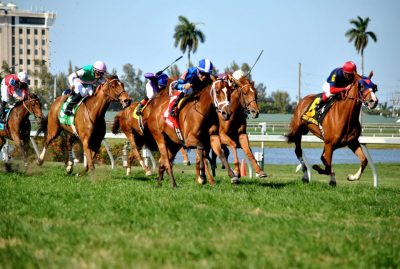
Regalo Mia wins for Michelle Nihei (photo courtesy of Michelle Nihei).
A diminutive filly, whose heart and determination were much larger than her size, went onto become a multiple stakes winner for Nihei as well. Regalo Mia embodies the spirit of racehorses Nihei finds so compelling. The Florida-bred daughter of Sligo Bay, out of the Red Bullet broodmare Shake it up, was bred by Juvenal Diaz, and raced in the silks of Steven W. Ciccarone.
“She was also one of the little surprises in life that have been really special,” said Nihei. “I wasn’t going to pretend that I knew she was going to be great. She was very small, she was very athletic and I thought that this was a nice little athlete for a new client. I knew she would be useful.”
Regalo Mia won the 2013 Orchid Handicap (G3) and the Sunshine Millions Filly and Mare Turf, both at Gulfstream Park, the same track where she broke her maiden, also on the turf.
“I convinced [Ciccarone] to bring him to the barn for us,” said Nihei. “And she just ended up being a terrific, wonderful filly. I continue to have a fantastic relationship with her owner. We’ve continued to be friends, as well as a trainer-client. She was an exceptionally important horse in the barn. She’s that sort of small underdog that’s all heart, all brain … [that] would compete with her very last breath. I was very lucky to have her. I’m so glad he brought her into the barn.”
Recognizing Talent and Potential
Nihei had the good fortune of galloping and developing a number of outstanding horses. One was multiple Eclipse Award winner and National Museum of Racing and Hall of Fame inductee Ashado. Those experiences provided her with great insight into recognizing the promise and potential of horses coming through her barn.
“One of the things that people forget, not everybody, but a lot of people dismiss how important it is to know when you have something brilliant around,” said Nihei. “It’s just like anything in life; if you’ve been to the Olympics, you know what it takes to get there. If you’ve had that opportunity to be on that caliber of horse, you never forget what that feels like. You never have that moment of indecision, ‘I wonder if this is a good horse.’”
However, sometimes those runners can emerge from anywhere and there are those horses that have the ability to fool you, the conditioner added.
“The ones that you don’t know anything about,” said Nihei. “It teaches you that you have to give them all opportunities, because every one of them needs to be treated like a champion until proven otherwise.”
A daughter of Arch, who made her first eight starts outside of the U.S. before being transferred to Nihei’s barn, became a multiple stakes-placed mare under her conditioning. Woodford Belle raced in the silks of Catesby Clay and would go onto place second in the Grey Goose Bewitch Stakes (G3) and run third in the The Very One Stakes (G3). It provided Nihei with an opportunity to look at the puzzle and identify something that had been missed previously.
“Woodford Belle was a horse we had five or six years ago,” said Nihei. “She came in with very little on her resume and ended up being multiple graded stakes placed. It obviously helped her pedigree as a dam, now later on in her life.”
But challenges persist in an industry known for its pitfalls and adversity, as well as its joys and triumphs.
“The individual is the individual,” said Nihei. “Sometimes, you’re benefitted from the luxury of a good pedigree. It doesn’t happen as much these days. You really just have to find the needle in the haystack — that tiny piece of wheat, sorting it from the chaff.”
A Compelling Catalyst
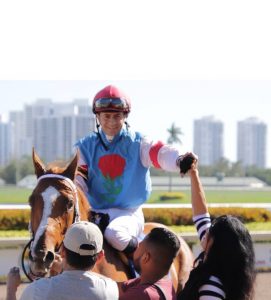
Mayrhofen, ridden by Luca Pacini, breaks his maiden at Gulfstream Park (photo courtesy of Michelle Nihei).
Barn depth, talented horses and caring owners, provide Nihei with all of the motivation she needs to get out of bed in the morning.
“As long as we have motivated clients that are in a position to do good things for their horses and get the best for them, I always feel that there’s an exciting puzzle involved,” said Nihei. “They’re all meaningful to me. I love having very competitive high-end horses. There are days when we don’t. It’s so satisfying to see them running across that line first. But I will say this: One of the things about having better horses is that they do keep you in the spotlight a little bit more than not. That’s certainly an element of all of it. It just doesn’t necessarily happen when you have a very small barn, which is where we are right now. We’re a little bit of a boutique barn, I guess.”
However, Nihei has several horses possessing promise and precocity, and it’s that depth of talent that makes the game fun and interesting, as they evolve as athletes.
“Everybody lives for the two-year-olds, it’s those horses that are developing and progressing,” said Nihei. “You know there’s the saying, ‘No one ever dies with a two-year-old in the barn.’ That’s probably true. We have some three-year-olds; one of them hasn’t had an opportunity to start yet because she was just late to the party. Another one is continuously progressing and just getting better. Those horses make you feel good about what you’re doing, simply because of the imminence. They show you that you’re on the right path. They needed some help and are improving for that.”
Mayrhofen is among the horses in Nihei’s barn to keep an eye on. The son of Curlin, out of the Regal Classic broodmare Teenage Queen, broke his maiden on Dec. 29, 2017 at Gulfstream Park.
“He was a maiden fifty [-thousand dollar claimer], but I think he’s coming along in a nice way,” said Nihei. “He and Lanitz are probably the point guards.”
Base of Operations
This is the third year that Palm Meadows has served as Nihei’s year-round base of operations. There were two primary reasons for being stabled at the Boynton Beach, Florida training center. One of those was the idea of being based at one place for the entire year and at a central location, one that allows for ease of shipping to Kentucky Downs or Saratoga. The stability of the facility, being a training center and with the Gulfstream Park racing program being 12 months a year, were also a variables in the equation. And the opportunity to keep the horses at Palm Meadows was very important to Nihei.
“I didn’t want to be at Gulfstream, I didn’t want to base from Miami, but I do want to base from a training center,” said Nihei. “Even though it does get active at this time of year [winter], the rest of the year it’s not nearly as busy. It’s an extremely attractive place to condition horses. We’re in a zip code that gets some relief from the really heavy hitters in the summertime. Florida allows us survivable situations purse-wise, as well as competition-wise.”
Finding New Prospects
Nihei has also attends several sales each year, spending the preponderance of her time in Florida, particularly south Florida, but she occasionally goes elsewhere.
“The Keeneland Yearling Sale is something that I’ve always paid attention to, attended and have bought a few horses here and there,” said Nihei. “Every once in a while, there’s some interest in a horse or two at Saratoga. In general, I try to stay away from there, because there are such heavy hitters going in with a lot of deep pockets. I think from the standpoint of being financially responsible, I encourage most of my owners to stay closer to home.”


